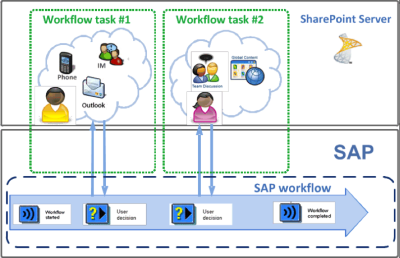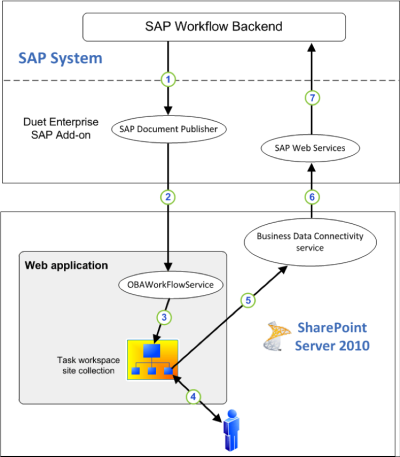One of the Duet Enterprise core capabilities is publishing SAP workflows into the realm of SharePoint sites. In this posting I outline the conceptual working, and what implications result from the Duet Enterprise workflow architecture. The information below is not entirely new, but builds upon blog material of Xiaosheng (Edward) Lu [SAP AG] and Kiki Shuxteau [Microsoft Corp].
This blog is earlier published on SAP Community Network Blogs
Prerequisites for exposing a SAP workflow via Duet Enterprise
- SAP ERP workflow; it does not matter whether a standard workflow, or a company-custom developed one. SAP BPM workflows are currently not supported for Duet Enterpise exposition.
- The SAP workflow must contain one or more discrete user interaction tasks.
- Duet Enterprise out-of-the-box supports User Decision interaction step. Interaction task with an Activitity Dialog are also supported, but require some manual work. Effectively you need to replace both the SAP GUI screenhandling plus propagate the dialog resultdata as outcome for the SAP workflow Activity Dialog task.

source: Microsoft Technet
Conceptual working
The following steps are performed in the exposition of a SAP ERP workflow interaction task to SharePoint context:
- In the SAP ERP workflow a status change occurs that next requires user interaction to act upon, via a SAP Workflow Interaction Task (Decision Step or Activity Dialog). When the SAP Workflow reaches the Interation Task, a Duet Enterprise specific outbound handler is invoked from within the runtime context of SAP workflow execution. This outbound handler uploads an XML payload document, containing the workflow instance details, to the associated [by configuration] SharePoint workflow subsite. In the Duet Enterprise architecture, this XML payload is send from SAP ERP Workflow context via the SAP Document Publisher, which resides on the Duet Enterprise SAP Add-on. The SAP Document Publisher service on its turn invokes the SharePoint OBAWorkflowService, which is deployed in the SharePoint farm as part of Duet Enterprise installation.
- On the receiving SharePoint document library [in the workflow subsite] is a Duet Enterprise specific SharePoint workflow configured. This workflow is triggered on addition of new content in the document library. The workflow contains 1 user task to act from the context of SharePoint user interface upon the specific surfaced SAP interaction task.
- The decision made by the SharePoint enduser in the SharePoint workflow task, is propagated to the SAP ERP workflow by means of a taskflow BDC entity. Duet Enterprise specific SAP webservices are herefore invoked via SharePoint BCS. These SAP webservices next invoke a Duet Enterprise specific inbound handler to receive and process the exchanged decision details, and propagate it as outcome of the user interaction task in the SAP ERP workflow.

source: Microsoft Technet
Implications
- Duet Enterprise provides default Function Modules for both inbound and outbound handlers. By design, these are limited to generic handling of SAP workflow. In case the SAP ERP workflow decision task includes context information that is workflow specific, it is required to build a custom outbound handler. Also in case the result datacontainer of the decision task contains context data besides or instead of a simple decision outcome, it is required to build a custom inbound handler to process that received data from SharePoint task into the SAP workflow.
- In concrete reality, SAP workflows more often than not involve acting upon workflow specific data. In all such situations it is thus required to overload the default function module with a custom implementation, for surfacing that specific data outside the boundaries of the SAP workflow.
- The default Duet Enterprise outbound handler S_OSP_WF_PAT_DEFAULT_CH_OB handles the publishing of XML payload to SharePoint. Even in case of a custom outbound handler, it must therefore still be utilized in the Duet Enterprise workflow publication. More specifically, the S_OSP_WF_PAT_DEFAULT_CH_OB outbound handler must always be the last invoked outbound handler in the SAP workflow outbound handlers pipeline. The order in which outbound handlers are invoked is configured within SAP ERP, not in the SCL (aka Gateway).
- The default Duet Enterprise inbound handler S_OSP_WF_PAT_DEFAULT_CH_IB handles the receiving of Duet Enterprise taskflow entity from SharePoint BCS. It must therefore always be present as the first invoked inbound handler in the SAP workflow inbound handlers pipeline.
















